Mechanical and Tribological Properties of Polytetrafluoroethylene Composites with Carbon Fiber and Layered Silicate Fillers
Abstract
:1. Introduction
2. Results and Discussion
2.1. Mechanical Properties
2.2. Tribological Properties
3. Materials and Methods
3.1. Materials
3.2. Sample Preparation
3.3. Characterization
4. Conclusions
Author Contributions
Funding
Conflicts of Interest
References
- Higaki, Y.; Ishige, R.; Takahara, A. Fluoropolymer surfaces/interfaces. In Handbook of Fluoropolymer Science and Technology; Smith, D.W., Iacono, S.T., Iyer, S.S., Eds.; John Wiley & Sons, Inc.: Hoboken, NJ, USA, 2014; pp. 433–450. ISBN 978-1-118-85022-0. [Google Scholar]
- Ebnesajjad, S. Filled fluoropolymer compounds. In Fluoroplastics, 2nd ed.; Ebnesajjad, S., Ed.; William Andrew Publishing: Oxford, UK, 2015; Volume 1, pp. 336–381. ISBN 978-1-4557-3199-2. [Google Scholar]
- Tanaka, K.; Kawakami, S. Effect of various fillers on the friction and wear of polytetrafluoroethylene-based composites. Wear 1982, 79, 221–234. [Google Scholar] [CrossRef]
- Friedrich, K.; Zhang, Z.; Schlarb, A. Effects of various fillers on the sliding wear of polymer composites. Compos. Sci. Technol. 2005, 65, 2329–2343. [Google Scholar] [CrossRef]
- Shi, Y.; Feng, X.; Wang, H.; Lu, X. Tribological properties of PTFE composites filled with surface-treated carbon fiber. J. Mater. Sci. 2007, 42, 8465–8469. [Google Scholar] [CrossRef]
- Wang, L.; Wang, S.; Wen, D.; Wang, G.; Yang, L. The study of the composite material Go/CF/PTFE tribological property. MATEC Web of Conferences 2017, 130, 09005. [Google Scholar] [CrossRef]
- Osman, M.A. Organo-vermiculites: synthesis, structure and properties. Platelike nanoparticles with high aspect ratio. J. Mater. Chem. 2006, 16, 3007. [Google Scholar] [CrossRef]
- Alexandre, M.; Dubois, P. Polymer-layered silicate nanocomposites: Preparation, properties and uses of a new class of materials. Mater. Sci. Eng. R 2000, 28, 1–63. [Google Scholar] [CrossRef]
- Sinha Ray, S.; Okamoto, M. Polymer/layered silicate nanocomposites: A review from preparation to processing. Prog. Polym. Sci. 2003, 28, 1539–1641. [Google Scholar] [CrossRef]
- Kirillina, Y.V.; Lazareva, N.N.; Sleptsova, S.A.; Okhlopkova, A.A. Effect of organomodified layered silicates on the properties and structure of polytetrafluoroethylene. Polym. Sci. Ser. A 2016, 58, 95–101. [Google Scholar] [CrossRef]
- Sleptsova, S.A.; Afanas’eva, E.S.; Grigor’eva, V.P. Structure and tribological behavior of polytetrafluoroethylene modified with layered silicates. J. Frict. Wear 2009, 30, 431–437. [Google Scholar] [CrossRef]
- Sleptsova, S.A.; Kapitonova, Y.V.; Lazareva, N.N.; Makarov, M.M. Wear-resistant polymer composites based on polytetrafluoroethylene and layered silicates. KnE Mater. Sci. 2016, 1, 149–154. [Google Scholar] [CrossRef]
- Song, F.; Wang, Q.; Wang, T. Effects of glass fiber and molybdenum disulfide on tribological behaviors and PV limit of chopped carbon fiber reinforced polytetrafluoroethylene composites. Tribol. Int. 2016, 104, 392–401. [Google Scholar] [CrossRef]
- Zhu, J.; Shi, Y.; Feng, X.; Wang, H.; Lu, X. Prediction on tribological properties of carbon fiber and TiO2 synergistic reinforced polytetrafluoroethylene composites with artificial neural networks. Mater. Des. 2009, 30, 1042–1049. [Google Scholar] [CrossRef]
- Chang, L.; Friedrich, K. Enhancement effect of nanoparticles on the sliding wear of short fiber-reinforced polymer composites: A critical discussion of wear mechanisms. Tribol. Int. 2010, 43, 2355–2364. [Google Scholar] [CrossRef]
- Kropotin, O.V.; Mashkov, Y.K.; Egorova, V.A.; Kurguzova, O.A. Effect of carbon modifiers on the structure and wear resistance of polytetrafluoroethylene-based polymer nanocomposites. Tech. Phys. 2014, 59, 696–700. [Google Scholar] [CrossRef]
- Kalistratova, L.F.; Mashkov, Y.K.; Egorova, V.A. Calculation of X-ray density of amorphous–crystalline polymer taking into account degree of ordering of amorphous phase. Inorg. Mater. Appl. Res. 2018, 4, 687–692. [Google Scholar] [CrossRef]
- Tang, L.-G.; Kardos, J.L. A review of methods for improving the interfacial adhesion between carbon fiber and polymer matrix. Polym. Compos. 1997, 18, 100–113. [Google Scholar] [CrossRef]
- Shelestova, V.A.; Grakovich, P.N.; Zhandarov, S.F. A fluoropolymer coating on carbon fibers improves their adhesive interaction with PTFE matrix. Compos. Interf. 2011, 18, 419–440. [Google Scholar] [CrossRef]
- Chen, B.; Wang, J.; Yan, F. Boston ivy-like clinging of dendritic polytetrafluoroethylene nano-ribbons to the surface of carbon fiber. Compos. Appl. Sci. Manuf. 2012, 43, 1028–1031. [Google Scholar] [CrossRef]
- Chen, B.; Wang, J.; Yan, F. Synergism of carbon fiber and polyimide in polytetrafluoroethylene-based composites: Friction and wear behavior under sea water lubrication. Mater. Des. 1980–2015 2012, 36, 366–371. [Google Scholar] [CrossRef]
- Wang, J.; Chen, B.; Liu, N.; Han, G.; Yan, F. Combined effects of fiber/matrix interface and water absorption on the tribological behaviors of water-lubricated polytetrafluoroethylene-based composites reinforced with carbon and basalt fibers. Compos. Part Appl. Sci. Manuf. 2014, 59, 85–92. [Google Scholar] [CrossRef]
- Biswas, S.K.; Vijayan, K. Friction and wear of PTFE—a review. Wear 1992, 158, 193–211. [Google Scholar] [CrossRef]
- Harris, K.L.; Pitenis, A.A.; Sawyer, W.G.; Krick, B.A.; Blackman, G.S.; Kasprzak, D.J.; Junk, C.P. PTFE tribology and the role of mechanochemistry in the development of protective surface films. Macromolecules 2015, 48, 3739–3745. [Google Scholar] [CrossRef]
- Ye, J.; Khare, H.S.; Burris, D.L. Transfer film evolution and its role in promoting ultra-low wear of a PTFE nanocomposite. Wear 2013, 297, 1095–1102. [Google Scholar] [CrossRef]
- Ohlopkova, A.A.; Struchkova, T.S.; Vasilev, A.P.; Alexeev, A.G. Studying the properties and structure of polytetrafluoroethylene filled with Belum modified carbon fibers. J. Frict. Wear 2016, 37, 529–534. [Google Scholar] [CrossRef]
- Myshkin, N.K.; Petrokovets, M.I.; Kovalev, A.V. Tribology of polymers: Adhesion, friction, wear, and mass-transfer. Tribol. Int. 2005, 38, 910–921. [Google Scholar] [CrossRef]
- Tanaka, K.; Yamada, Y.; Ueda, S. Effect of temperature on the friction and wear of heat-resistant polymer-based composites. J. Synth. Lubr. 1992, 8, 281–294. [Google Scholar] [CrossRef]
- Sawyer, W.G.; Argibay, N.; Burris, D.L.; Krick, B.A. Mechanistic Studies in Friction and Wear of Bulk Materials. Annu. Rev. Mater. Res. 2014, 44, 395–427. [Google Scholar] [CrossRef]
- Österle, W.; Dmitriev, A.I.; Wetzel, B.; Zhang, G.; Häusler, I.; Jim, B.C. The role of carbon fibers and silica nanoparticles on friction and wear reduction of an advanced polymer matrix composite. Mater. Design 2016, 93, 474–484. [Google Scholar] [CrossRef]
- Shelestova, V.A.; Zhandarov, S.F.; Danchenko, S.G.; Grakovich, P.N. Surface modification of carbon fiber by fluoropolymer in a low-temperature plasma. Inorg. Mater. Appl. Res. 2015, 6, 219–224. [Google Scholar] [CrossRef]
- Krick, B.A.; Ewin, J.J.; Blackman, G.S.; Junk, C.P.; Gregory Sawyer, W. Environmental dependence of ultra-low wear behavior of polytetrafluoroethylene (PTFE) and alumina composites suggests tribochemical mechanisms. Tribol. Int. 2012, 51, 42–46. [Google Scholar] [CrossRef]
Sample Availability: Samples of the UHMWPE, vermiculite, kaolinite, carbon fibers and composites are available from the authors. |
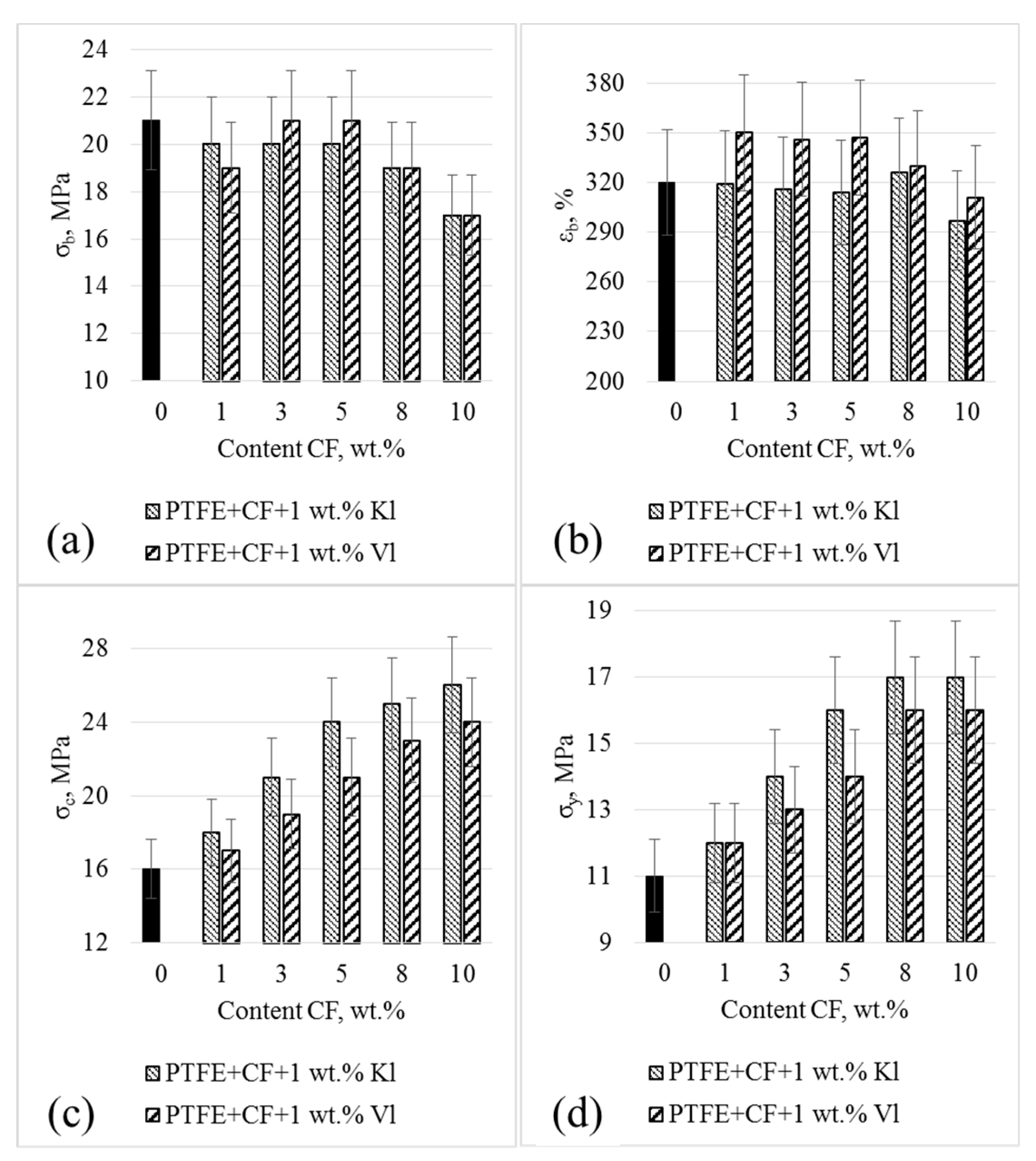


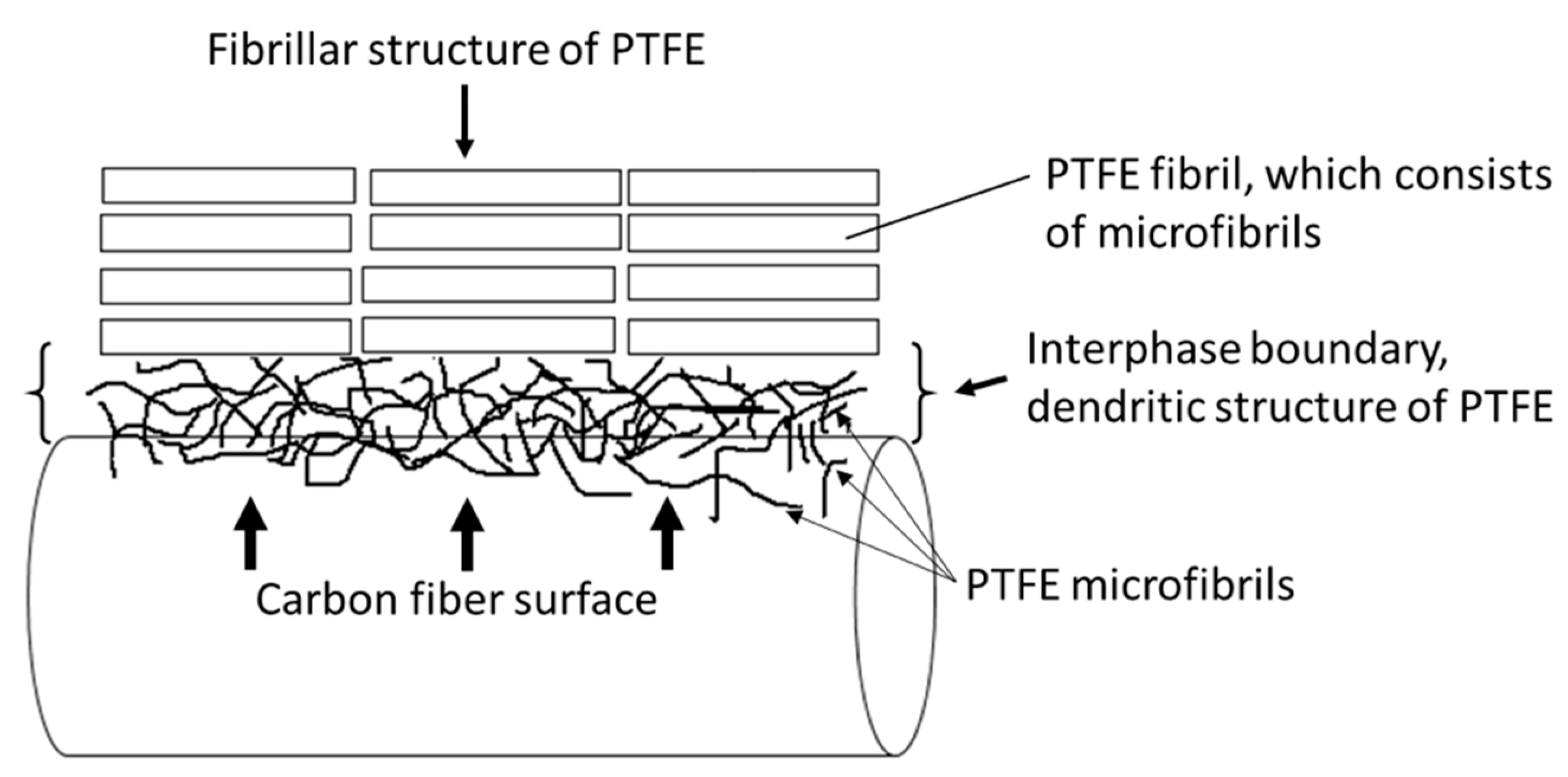


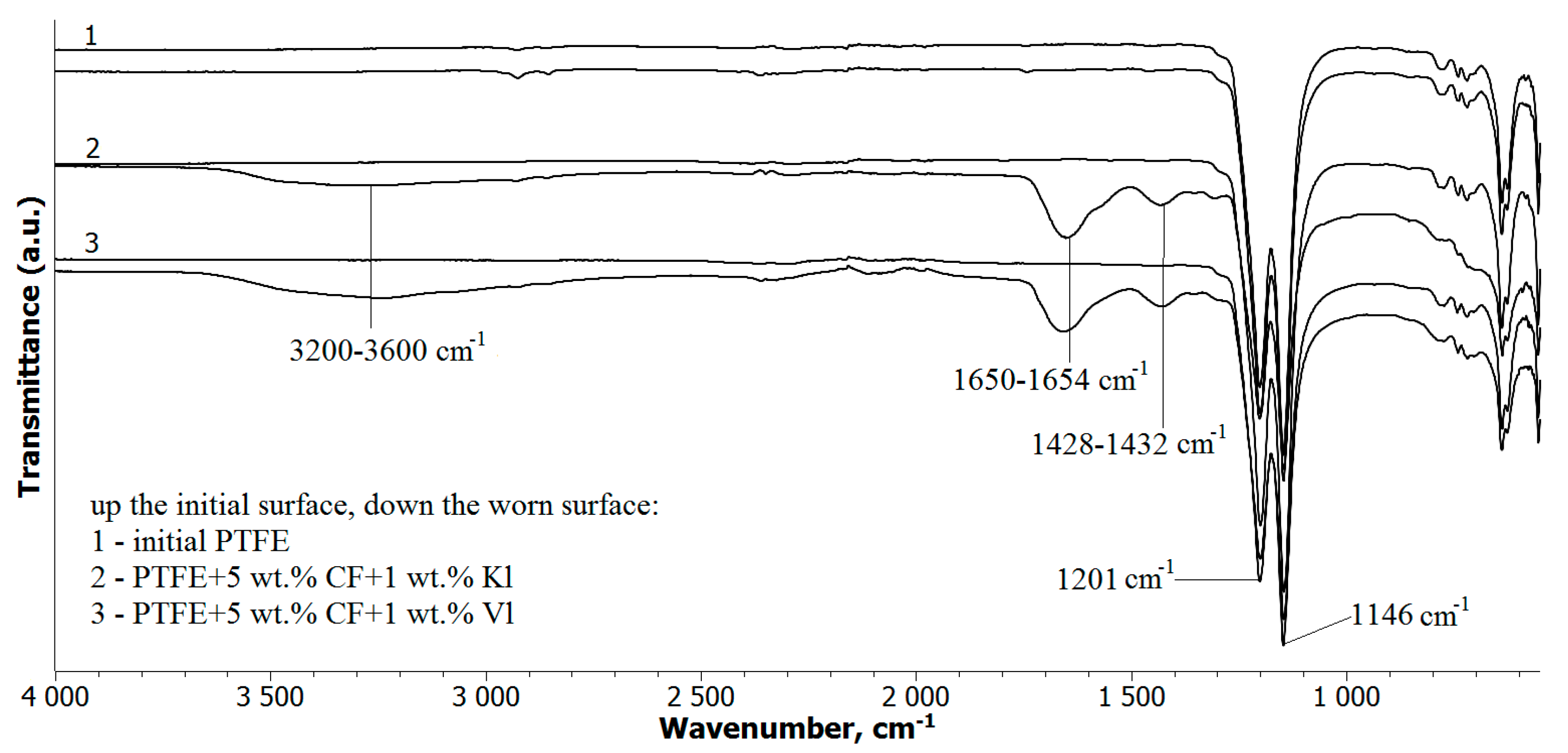
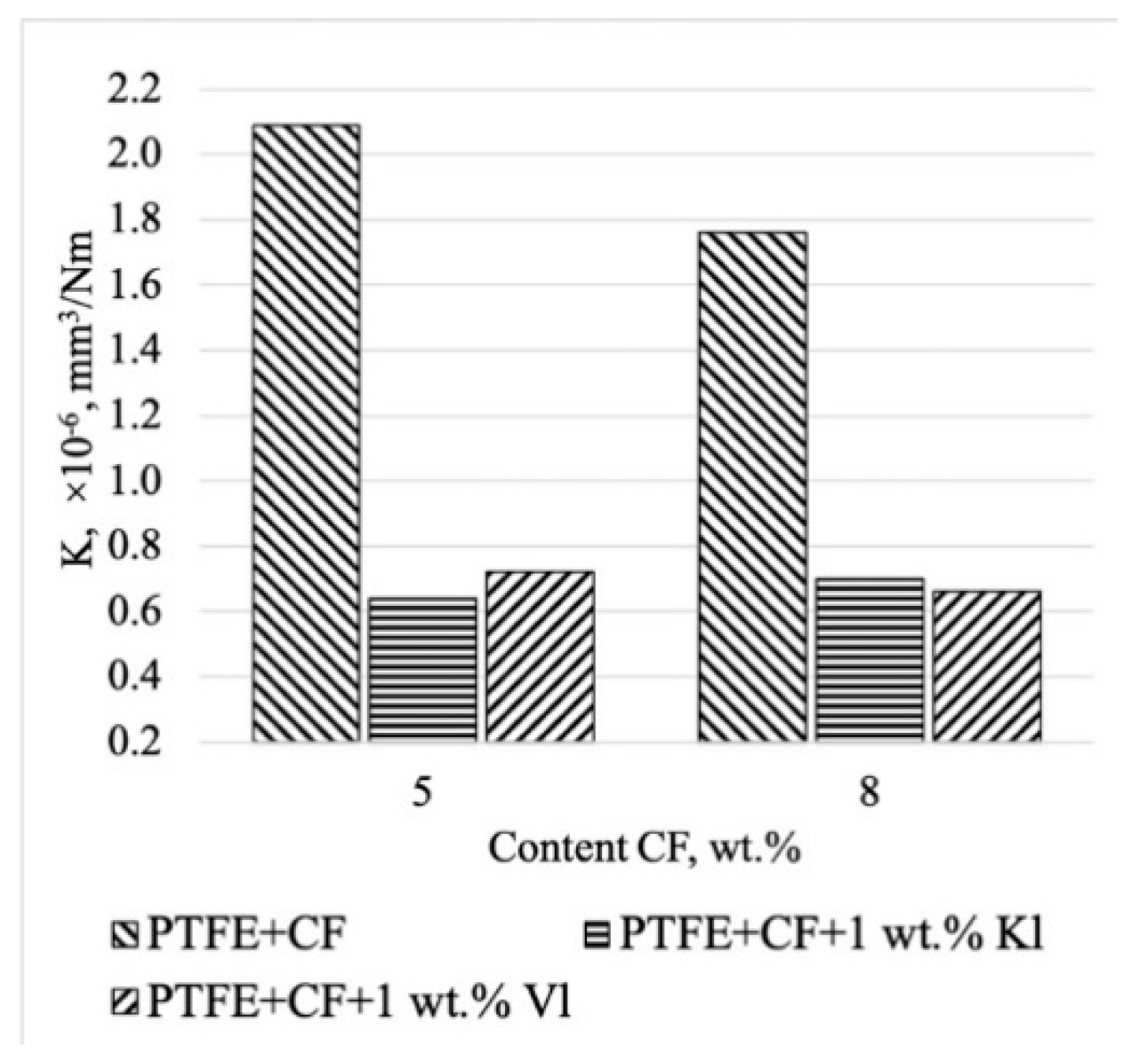
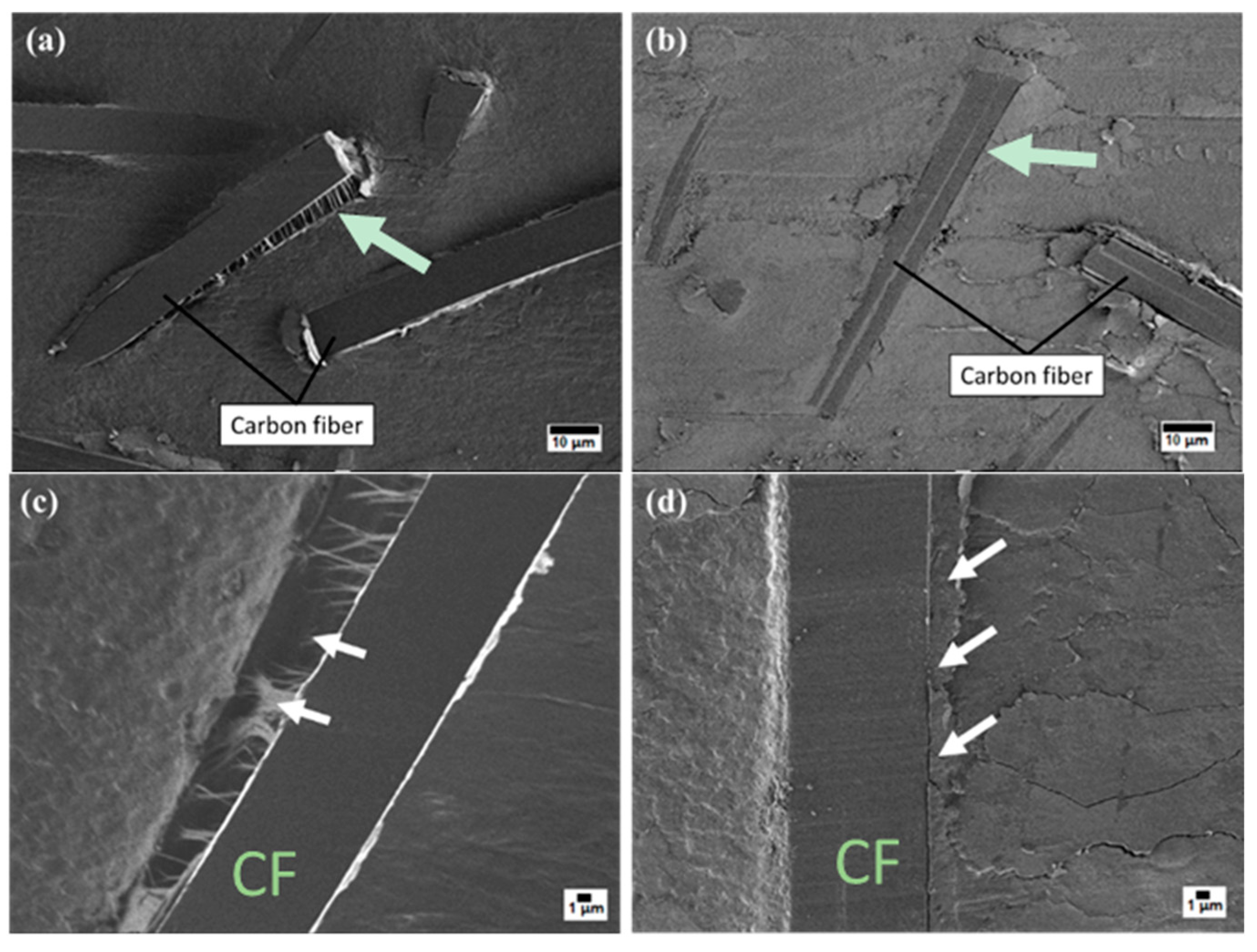

| Content of CF, wt % | Theoretical Density, g/cm3 | Experimental Density, g/cm3 | XRD, % | ||||
|---|---|---|---|---|---|---|---|
| PTFE/CF | PTFE/CF/Kl | PTFE/CF/Vl | PTFE/CF | PTFE/CF | PTFE/CF/Kl | PTFE/CF/Vl | |
| 0 | 2.20 | 2.15 ± 0.01 | 2.16 ± 0.01 | 2.16 ± 0.01 | 63 ± 1 | 65 ± 1 | 64 ± 1 |
| 1 | 2.19 | 2.15 ± 0.01 | 2.16 ± 0.01 | 2.15 ± 0.01 | 64 ± 1 | 67 ± 1 | 66 ± 1 |
| 3 | 2.18 | 2.13 ± 0.01 | 2.14 ± 0.01 | 2.13 ± 0.01 | 68 ± 1 | 69 ± 1 | 69 ± 1 |
| 5 | 2.16 | 2.11 ± 0.01 | 2.11 ± 0.01 | 2.10 ± 0.01 | 69 ± 1 | 72 ± 1 | 71 ± 1 |
| 8 | 2.13 | 2.09 ± 0.01 | 2.08 ± 0.01 | 2.06 ± 0.01 | 71 ± 1 | 74 ± 1 | 73 ± 1 |
| 10 | 2.11 | 2.06 ± 0.01 | 2.06 ± 0.01 | 2.03 ± 0.01 | 73 ± 1 | 74 ± 1 | 74 ± 1 |
© 2019 by the authors. Licensee MDPI, Basel, Switzerland. This article is an open access article distributed under the terms and conditions of the Creative Commons Attribution (CC BY) license (http://creativecommons.org/licenses/by/4.0/).
Share and Cite
Vasilev, A.P.; Struchkova, T.S.; Nikiforov, L.A.; Okhlopkova, A.A.; Grakovich, P.N.; Shim, E.L.; Cho, J.-H. Mechanical and Tribological Properties of Polytetrafluoroethylene Composites with Carbon Fiber and Layered Silicate Fillers. Molecules 2019, 24, 224. https://doi.org/10.3390/molecules24020224
Vasilev AP, Struchkova TS, Nikiforov LA, Okhlopkova AA, Grakovich PN, Shim EL, Cho J-H. Mechanical and Tribological Properties of Polytetrafluoroethylene Composites with Carbon Fiber and Layered Silicate Fillers. Molecules. 2019; 24(2):224. https://doi.org/10.3390/molecules24020224
Chicago/Turabian StyleVasilev, Andrey P., Tatyana S. Struchkova, Leonid A. Nikiforov, Aitalina A. Okhlopkova, Petr N. Grakovich, Ee Le Shim, and Jin-Ho Cho. 2019. "Mechanical and Tribological Properties of Polytetrafluoroethylene Composites with Carbon Fiber and Layered Silicate Fillers" Molecules 24, no. 2: 224. https://doi.org/10.3390/molecules24020224
APA StyleVasilev, A. P., Struchkova, T. S., Nikiforov, L. A., Okhlopkova, A. A., Grakovich, P. N., Shim, E. L., & Cho, J.-H. (2019). Mechanical and Tribological Properties of Polytetrafluoroethylene Composites with Carbon Fiber and Layered Silicate Fillers. Molecules, 24(2), 224. https://doi.org/10.3390/molecules24020224





